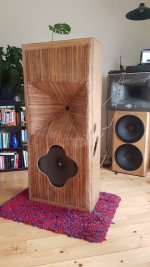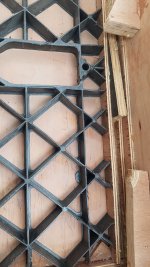Slow progress pix.
One image shows the in-progress speaker in the foreground. The midbass box in the background will (eventually) transition to sub use.
The other image shows how I'm using up scraps in this build. The translam sections are ply offcuts. The plastic grid is a section cut from a damaged pallet.
I got impatient, and fired the speaker up, incomplete. No back, no foam, just a simple open backed 2-way (700Hz cross, same DSP settings as prior speaker used).
Subjective impressions:
1) The horn is good. Dispersion seems quite even*.
2) There's an unnatural sizzle on cymbals and silbilance on female vocals.
3) The 18" is loafing at the levels I play.
A FR sweep shows (using same EQ as prior horn) not much difference:
a) HF is a bit different, with a small 9.5kHz spike, presumably the cause of the silbilance. I assume that's due to a throat or driver mounting problem.
b) a 2-3kHz bulge.
...that's much less difference than I thought there would be.
After applying quick + crude EQ to flatten these, it seems like a very natural, easy speaker.
* one odd effect: the prior speaker sounded really odd when my head was almost on the floor, e.g. when doing push ups, music would sound harsh and unnatural for part of the movement.
The new one doesn't do this - it sounds fine in the same situation.
One image shows the in-progress speaker in the foreground. The midbass box in the background will (eventually) transition to sub use.
The other image shows how I'm using up scraps in this build. The translam sections are ply offcuts. The plastic grid is a section cut from a damaged pallet.
I got impatient, and fired the speaker up, incomplete. No back, no foam, just a simple open backed 2-way (700Hz cross, same DSP settings as prior speaker used).
Subjective impressions:
1) The horn is good. Dispersion seems quite even*.
2) There's an unnatural sizzle on cymbals and silbilance on female vocals.
3) The 18" is loafing at the levels I play.
A FR sweep shows (using same EQ as prior horn) not much difference:
a) HF is a bit different, with a small 9.5kHz spike, presumably the cause of the silbilance. I assume that's due to a throat or driver mounting problem.
b) a 2-3kHz bulge.
...that's much less difference than I thought there would be.
After applying quick + crude EQ to flatten these, it seems like a very natural, easy speaker.
* one odd effect: the prior speaker sounded really odd when my head was almost on the floor, e.g. when doing push ups, music would sound harsh and unnatural for part of the movement.
The new one doesn't do this - it sounds fine in the same situation.
Attachments
Congrats!
Have you measured the thing outdoors yet? How do bass and horn directivities match? It the bass leaky/cardioid?
Have you measured the thing outdoors yet? How do bass and horn directivities match? It the bass leaky/cardioid?
I don't fully understand it either. I can visualise how a figure 8 pattern can form but not the more complex shapes.
It's all about the interaction. Perfect overlap of front and rear pressure leads to 0 sound, right? So in a dipole, that happens more to the sides, but of course the longer the wavelength the less the distance matters so you have more overall loss with decreasing frequency. When you add a resistance into that mix, you're just steering the cancellation nodes. The side-damped open-backed box, for instance, creates a cancellation to the sides that's damped by a mix of the distance and damping losses, but the remaining "front" energy from the driver can reach the remaining "rear" energy (Remaining front and rear energy being that which isn't being cancelled on the sides of the enclosure) and causes a rearward null because that's where you're letting the bulk of the cancellation occur. Other shapes and flavors vary this theme up, but by only allowing the cancellation to take place where (walls) and to what extent (damping) you want, you can steer those nulls, in the case of cardioid, it's directly to the rear.
It's just a matter of damping and directing the cancellations.
No. I'm taking forever on this 🙂Congrats!
Have you measured the thing outdoors yet?
Not sure.How do bass and horn directivities match?
It is currently a 'normal' 2-way, crossed at 700Hz, whereas the prototype (in post 2) was a 3-way, using a multiple entry horn, crossed at 400Hz.
Hence, for the finished build, it's somewhere around 400Hz* that I'll be trying to get a directivity match.
The cutout for the 18" woofer probably widens dispersion a little (which is counter productive), but I like how it looks, and so does my GF. Now that she's seen this version, she doesn't want me to make a normal (round) cutout.
Not yet. Doesn't even have a back yet. I also haven't tried it near a wall, or in stereo.It the bass leaky/cardioid?
Adding a back might be a step backwards.
The speaker looks awesome. Sounds like it's going to work well for you too!
Thanks. The surface is still a bit rough and unfinished, but I'm fairly happy with how it is looking.
I've got plans to tweak them, so the finished version will look a little better, I hope.
*I'll set the Xover to whatever is subjectively the best. The vintage woofers aren't quite identical, and the room position won't be identical, so maybe it will end up with one channel having a higher Xover than the other. There's plenty of driver overlap to play with.
- Status
- Not open for further replies.

